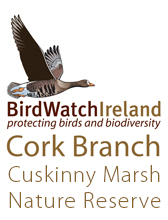Birds
As far as we are aware regular recording of the bird life of BWI Cuskinny Marsh Nature Reserve did not take place until the early 1970s with no records from before that date currently available.
It was in January 1990 that an official Birdwatch Ireland Nature reserve was established on the site and since then some management work has been carried out in an attempt to improve the habitat for birds. In the summer of 1992 the area of the reserve was greatly increased, incorporating most of the uncultivated land surrounding the lake.
For the purpose of recording wildlife sightings etc. on the reserve we also include Cuskinny Bay which is on the southern boundary of the reserve and is always worth checking when visiting the area.




